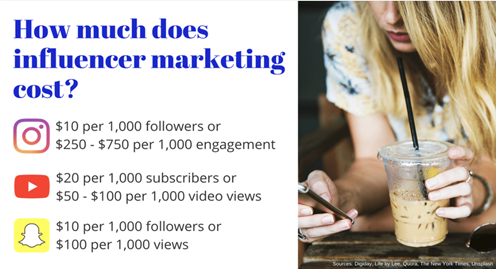Reaching New Audiences With Influencer Marketing

Influencer marketing is one of the fastest-growing digital marketing channels today, nearly tripling in value in recent years to an estimated $9.7 billion. Brands are shifting, when possible, from traditional advertising to social media star power to reach and engage diverse consumers on their turf. And so far, it’s working. For every dollar spent on influencers, brands are getting an average of $5.78 in ROI. Even more impressive, influencer marketing campaigns generate 11x the ROI of any other digital advertising channel.
As a relatively young marketing channel, influencer marketing leverages relationships and word of mouth to market products through brand partnerships with social influencers and their millions of engaged followers. Fifty percent of consumers prefer getting product information from influencers and 34% have discovered brands exclusively through influencer posts.
But is influencer marketing right for your brand? Or is it a luxury reserved for major corporations with million-dollar budgets? We argue that any business, regardless of its stage, can run influencer marketing campaigns. But as with any new tactic you add to your marketing toolkit, it should align with your overarching marketing strategy and ladder up to your company’s business goals.
So, let’s assume you check all the boxes. Now what? Read on to learn how your company can create effective influencer marketing campaigns within your budget.
1. Define Your Influencer Marketing Goals
Influencer marketing is a hot topic these days, but to engage in it “just because” is poor strategy. Identify your why. Why are you looking to incorporate influencer marketing into your marketing strategy and how will it benefit your business? Are you looking for brand lift among a specific demographic or to boost social currency, like followership and engagement on Instagram?
As you answer these questions, take inventory of where you currently stand in the market so you have a better understanding of the work you need to do. Establish KPIs (key performance indicators) for metrics like reach, impressions, and clicks that will help you quantify results.
Finally, be realistic. It’s unlikely that your first campaign will go viral, and that’s okay. At this point, a big win for you is launching the campaign and learning from your mistakes.
2. Set a Reasonable Budget For Your Campaign
Since influencer marketing is evolving so quickly, brands are still trying to figure out the pricing models and scope. It’s common to underestimate campaign costs and overestimate delivery.
While compensation models vary, they typically range from pay-per-click, pay-per-engagement, and pay-per-post, to follower and reach based models based on an influencer’s follower or subscriber size. Many influencers also accept free products as forms of payment.
To start, carve out at least $1,000 – $10,000 of your marketing budget for influencer marketing as you get a feel for the market. According to Buffer, the cost for an influencer marketing campaign depends on the social platform:

3. Choose the Right Platforms to Maximize Effectiveness
Now that logistics are out of the way, it’s time to choose the channels you’ll use for your campaign. So often, we think of influencer marketing as just a social media initiative, more specifically, an Instagram initiative. But influencer marketing can take place on other channels as well. What’s important is choosing the channel that makes sense for your business because it reaches your audience.
If you’re a publisher, for example, you may want to focus your campaign on a platform like Audible that regularly features new books and already has an established audience looking for good reads. Or if you’re a fashion brand, you may reach out to a fashion influencer who will post stunning photos of themselves in your apparel on social media and in their fashion blog with additional commentary.
Pro Tip: Do your diligence when researching platforms and make sure the medium you choose can accommodate your specific goals. If your goal is to improve click-through rates, you may want to use LinkedIn or Twitter as Instagram’s platform doesn’t allow embedded links in posts.
4. Research “Social Scorecards” of Influences to Determine Fit
Now that you’ve locked in goals, target market, and content channels, it’s time to find your influencers.
One of the most popular platforms to source influencers is Influencity. With a database of over 70 million, the tool allows you to find influencers across Instagram, Twitter, YouTube, and TikTok. Robust search and discover features, campaign management, and analytics make this tool a brand favorite. But there are other platforms out there, so do your homework to ensure you find the tool that fits your business needs.
Pro Tip: Resist the urge to make your choice based on follower count alone. Put more stock in the influencer’s engagement rate which is determined by how well followers engage the influencer. For maximum engagement, aim for accounts with 10k-100k followers.
Source: bigcommerce.com
After curating your list, follow influencers on social media, study their communication style, and interact with their posts through comments and shares. When you’re ready, reach out in a private message and follow up with a direct email a few days later to formally request a brand collaboration.
To increase your chances of getting a yes, always supplement your request with an offer. A whopping 90% of influencers say receiving more products would improve their experience with brands. Whether that’s a free product or complimentary service, be prepared to ante up. This will give the influencer more of an incentive to partner with your business.
5. Be Intentional With Copy and Creative
There are several influencer marketing campaign strategies that have proven successful in various categories. The list includes social media takeovers and branded hashtags, affiliate marketing, competitions, and giveaways, and sponsored blog posts. Depending on your goals and influencer, you’ll want to choose a campaign that offers the least path of resistance to conversion.
Remember that the appeal of influencer marketing rests on authenticity, although it is often a paid placement. So be intentional about creating copy and creative that feels native and natural to the platform. And please note, the FTC requires all influencers to disclose paid sponsorships or endorsements (#sponsored).
6. Measure Results Against KPIs
Finally, measure the results of your campaign against your KPIs. Rather than manually tracking that data, you can use tools like Influencity‘s campaign tracker to view metrics like age, gender, and geographic distribution in real-time, allowing you to measure ROI according to your campaign objectives. For a list of similar resources, click here.
Key Takeaways:
Influencer marketing can introduce your brand to new audiences and yield impressive ROI. But you have to be S.M.A.R.T. about your execution. Knowing specifically what you want to accomplish with your influencer campaigns and how you’ll track your progress will help you determine what’s achievable and realistic with the budget and resources you have, and how much time to set aside.



